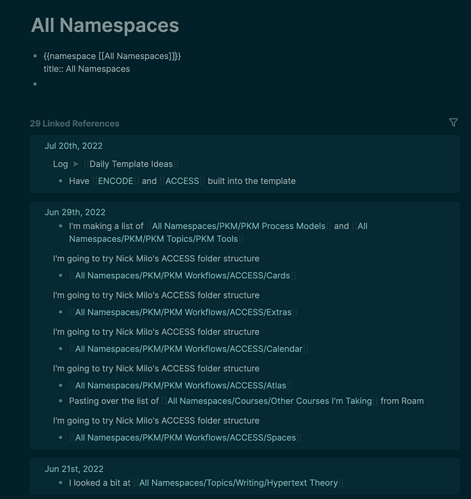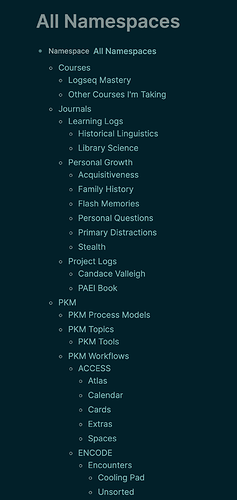- Why is this an anti-pattern?
- It’s an indented outline!
HIERARCHIES NEED NOT BE STRICT
- As alex0 says, there need be nothing “strict” about these hierarchies.
- Think of hierarchies as flashlight beams into your graph.
- You can have several, illuminating your graph from different angles.
- A block or page can turn up in several hierarchies.
- Sometimes you want to look into your graph, and go to a specific place, and start working there.
- It’s a wayfinding or orientation aid, exactly like Nick Milo’s MOC and Datascope concepts.
IT’S MORE LIKE AN “OUTLINER-STYLE” MOC HUB
- It’s fine if most of the pages in my graph don’t show up in this MOC-type of view of namespaces.
- I don’t intend this hierarchical “net” I’ve thrown across part of my graph to be exhaustive.
- I’d expect the number of pages directly returned by “Hierarchies” to be small, compared to the number returned by “All Pages”.
IT’S THE SAME OUTLINER PATTERN - AT A HIGHER LEVEL OF ORGANIZATION
- It’s just an way to visually review all the pages I’ve chosen to relate in branching patterns
- It lets me get into my graph spatially, instead of temporally.
- I’m a spatial/navigational thinker (not a visual thinker - I don’t need an infinite canvas and stickies!)
- I like & want Logseq’s default view of information - outlines - but at a higher level of organization (pages in namespaces)
SHORTCOMINGS OF MY INITIAL NAMESPACE-BASED EXAMPLE
In the example/screencap I shared, I used a hard-coded scheme based on namespaces. That may be distracting. It may make it seem like I only wanted this for namespaces.
Technically, it’s possible hierarchies could be created more flexibly, using queries and page properties, which alex0 figured out (as I describe below).
But for my own inadequate, limited, purely namespace-based example, I ran a query something like this:
And that returned something like this:
I WISH I COULD EDIT THAT RETURNED OUTLINE
But I can’t edit that outline, to add headers, and text blocks to explain what’s down each branch. That would make this a true MOC hub.
More ambitiously, it would be cool to move and rename pages here, and have those structural changes cascade through my graph.
Basically, Logseq won’t let us do to namespaced pages what it lets us do to blocks on pages. (Unless we do it manually).
I just want to keep doing my “Logseq thing”, over this higher level of organization.
IT’S ALREADY A FEATURE IN DEVELOPMENT
- It’s hard to see it as an anti-pattern when it’s already what gets returned by the {{namespace}} query.
- Logseq already supports a very rudimentary version of the feature of aggregating and displaying namespaced pages.
- I’m just providing input about how this existing feature can be enriched and expanded.
BEING "OUTLINE-STYLE MOC-FRIENDLY IS A GOOD DIFFERENTIATOR
- I think there is huge potential here for Logseq to become very distinct from both Roam and Obsidian.
- Why not support outlines above the level of the page - editable outlines of namespaced pages?
- Right now, we can build those manually
- But the namespace information exists in the database, so it could be automatically generated
- Alternatively, we could add a “type:: hierarchy” property that takes a path as a value maybe
- Then a system-provided “Hierarchies” page could show multiple hierarchies.
- Again, these would be like MOCs, not exhaustive TOCs of the graph
- “Hierarchies” becomes an MOC hub, not a document root for all pages
COMBINING NAMESPACE AND QUERY-BASED HIERARCHIES IN THE MOC HUB
- The hierarchy I explored was only a namespace-based one
- That’s only because I didn’t have the knowledge on how to do it using queries over properties.
- The queries + properties solution could be implemented if alex0’s Feature Request here was implemented: Specify and display relations between pages/tags.
- Namepace-based hierarchies and property-based ones could conceivably all appear in the MOC-hub (the “Hierarchies” page)
- If the information appearing there was editable (with restrictions), we could add headings into that “Hierarchies” outline to clarify what the different MOCs/hierarchies are
NOT AN ANTI-PATTERN (NECESSARILY)
-
tl;dr - I’M just saying that Parent-Child context matters, at a higher level than just on the page.
-
If this higher level of outlining was forced and exhaustive, it would be an anti-pattern
-
Since it’s not, it’s actually just a combination of the main pattern (indented outline) and a secondary pattern (namespaces) that is already supported
-
People would just have to be advised, as Nick Milo does for Obsidian users, that trying to make MOCs exhaustive is a bad idea.
-
MOCs are accelerators, not organizers.
-
It’s wayfinding for people who think about their personal information topically, instead of by today’s date.
SUPPORT HUMANS, NOT IDEOLOGIES
- Different people will differ in the amount of higher-level organization they need to avoid disorientation
- According to the book “The Science of Managing Our Digital Stuff”, most people far prefer navigational methods to search (for personal information management tasks).
- Using term-based methods like tagging or search is less preferred for personal info (unlike with public information like web pages)
NAVIGATION FREES UP MENTAL RESOURCES
- People need navigational structures because then they can rely on recognition instead of recall to access their info, and procedural rather than declarative memory
- This is especially important if ever Logseq wants to attract a user base that doesn’t necessarily use the tool every single day.
- Those kinds of users would need recognition-based cues to get reoriented to their graph, and not have to dredge up declarative memories of what might be in there.
- If the research findings about PIM hold up, the tool that achieves the best balance of navigational structure and distributed graph traversal will have a strong advantage in the marketplace
ENJOY THE MAGIC, BUT CHOOSE YOUR STARTING POINT
- The magic of graph traversal is you can have serendipitous discovery of linkages that grow in value over time
- But what is the value of doing that from an abstract, search-driven starting point every time?
- Why not chose a topic-based starting point or launchpad, and then enjoy the graph-traversal magic?
- Logseq can become the tool that best balances both wayfinding impulses, leveraging the new graph-traversal paradigm, with just-enough-wayfinding-structure for people more familiar with older approaches
PRAGMATISM OVER PURISM
- Roam is doctrinaire and purist about its graph database philosophy, and hostile to hierarchies.
- I finally became loyal to Logseq because I saw the word “Hierarchies” on a page!!
- (Also, because key evangelists were badly treated by Roam, I thought)
- Since it’s there, I figured the Hierarchies functionality would continue to be developed.
- It would make me sad to learn hierarchies are an anathema to the philosophy and culture of the Logseq developers.
- That’s why I asked: Would a rich commitment to hierarchies and classification be an anathema to Logseq culture?

